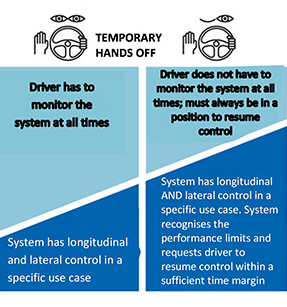 United States – Most rider organisations, federations, club groupings and the motorcycle industry have adopted a position or voiced concerns, or are working on how motorcycles and their riders are becoming increasingly affected by the introduction of vehicle assist systems which are leading towards the aim of fully automated vehicles.
United States – Most rider organisations, federations, club groupings and the motorcycle industry have adopted a position or voiced concerns, or are working on how motorcycles and their riders are becoming increasingly affected by the introduction of vehicle assist systems which are leading towards the aim of fully automated vehicles.
In February of this year we ran an article entitle Self Driving Cars – The Same Concerns which looked at the Motorcycle Riders Foundation (MRF) from the United States when they raised their concerns with their lawmakers regarding automated vehicles.
More recently the MRF took those concerns to the politicians in the nation’s capital Washington D.C. with their annual national rider lobby day – “Bikers Inside The Beltway”– which seeks to help educate Members of Congress about the issues facing motorcyclists today.”
The MRFs Vice-President of Government Affairs, Megan Ekstrom, has stated that, “The MRF is seeking assurances that any federal automated vehicle policy includes key considerations that are exclusive to motorcycles,”
“We want to work with Congress and policymakers to ensure that the unique needs and requirements of motorcyclists across the U.S. are being considered and accounted for.”
She went on to say, “Given motorcyclists’ smaller profile on our nation’s roadways in comparison to automobiles, commercial trucks, and other road users, assurances and requirements must be met to ensure that any technology can adequately and appropriately identify and respond to motorcycles in all traffic situations.”
The MRF are now gearing up for their yearly “Meeting of the Minds” where lobbyists, government representatives, policymakers, and riders from all across the country will be converging over a weekend in Denver, Colorado. The Meeting of the Minds is aimed toward politically active riders who want to expand their knowledge and political influence on behalf of freedom-loving motorcyclists everywhere.
Advocating For Riders’ Interests
A lot of countries around the world have more than one organisation which, either specifically or as part of their motorcycling/rider remit, advocate riders’ interests and rights.
The United States is no different in this respect with the American Motorcyclist Association (AMA) www.americanmotorcyclist.com apart from sanctioning competition and recreational events, the AMA has a mission to promote the motorcycle lifestyle and protect the future of motorcycling, advocating for riders’ interests at all levels of government.
It is no surprise that the AMA has adopted an official statement on automated vehicles calling on government agencies and elected officials to include motorcyclists in the ongoing discussion, planning and implementation of the policies and regulations governing the rollout of automated vehicles.
American Motorcyclist Association Adopts Official Statement
 In July of this year the AMA added a voice on automated vehicles by adopting an official position and statement on automated vehicles.
In July of this year the AMA added a voice on automated vehicles by adopting an official position and statement on automated vehicles.
The AMA calls on government agencies and elected officials to include motorcyclists in the ongoing discussion, planning and implementation of the policies and regulations governing the rollout of automated vehicles.
The AMA states, “Failure to specifically address motorcycles in statutory and regulatory language amounts to the abandonment of motorcycle safety by legislators and regulators,” the position statement reads. “Essentially, the issue of distracted and inattentive driving will mushroom into a monumental hazard for motorcyclists when flawed AV technology enters the transportation mainstream.”
The AMA President and CEO Rob Dingman said, “The position statement emerged from the organization’s ongoing involvement in this crucial issue and reinforces the organization’s commitment to motorcyclist safety.”
“This new position statement is an essential element in the association’s continuing efforts to convince regulators, technology companies and automakers to ensure that automated vehicles fully and effectively identify and properly respond to motorcycles in all traffic situations.”
Dingman went on to say, “We have been pursuing that goal ever since developers and manufacturers began testing these new technologies, and we will be redoubling our efforts as more companies put AVs (Automated Vehicles) into service on public roads.”
The AMA goes on to say that it recognises that some features being developed and tested may result in a reduction in the number of crashes and injuries involving motorcyclists. However they say that, no mandate is in place to require motorcyclists are included in the discussion or that motorcycles be specifically addressed during development of detection devices and software development.
The full text of the AMA position statement is available at Automated Vehicles and the Safety of Motorcyclists on the AMA website and here are a few salient points from that position statement.
The rush to market of driver-assist systems, semi-autonomous vehicles and highly automated vehicles—referred to collectively as “AVs”—poses a significant threat to motorcyclists when the developers of this technology and the vehicle manufacturers are not held to the highest safety standards throughout the entire development and implementation process.
If AV systems are not conceived and developed with motorcycles and motorcyclists in mind, the eventual result could be that motorcycles would be excluded from certain roadways, or, worse, banned from roads altogether.
Failure to specifically address motorcycles in statutory and regulatory language amounts to the abandonment of motorcycle safety by legislators and regulators. Essentially the issue of distracted and inattentive driving will mushroom into a monumental hazard for motorcyclists when flawed AV technology enters the transportation mainstream.
The American Motorcyclist Association position regarding AVs, V2V and V2I technology (Motorcycle Minds – Automated vehicles – Vehicle to Vehicle – Vehicle to Infrastructure) is such that these technologies must be thoroughly reviewed and tested to maximize crash avoidance involving motorcyclists. However, the rush to market for maximization of sales of AVs without complete and competent analysis of the relationship of motorcyclist safety to the AV environment, is an invitation to injury and death.
Simultaneously, the president and Congress, along with pertinent federal agencies, must hold vehicle manufacturers and those developing this technology accountable by enacting regulations and/or guidelines that include consideration of motorcycles and motorcyclists in the development and deployment processes.
The AMA now calls upon the president and Congress to immediately direct the appropriate federal agencies to implement automated-vehicle policy and guidelines to improve and ensure the safety of motorcyclists.

Meanwhile here in Europe the European Commission has communicated a strategy for mobility of the future – On the road to automated mobility
A few salient points from the strategy which we will look in more in-depth at a later stage, are:
- Driverless vehicles will change our lives, just as steam trains and motor cars did before them.
- Once the current teething problems have been properly addressed – and they must be, driverless vehicles could significantly improve road safety since human error is estimated to play a role in 94 per cent of accidents.
- However, we cannot expect such technological changes alone to solve the challenges of congestion, transport emissions and road fatalities.
- Ethical issues related to transferring the responsibility of driving to vehicles must also be addressed.
- Linked to this we need to ask ourselves who is liable when a driverless vehicle is involved in an accident.
- Driverless vehicles will have to share the roads or streets with non-automated cars and also with pedestrians, cyclist and motorcyclists. For this reason their deployment can only take place once overall road safety is guaranteed and not just the safety of automated vehicle users.
Let’s hope that those engaging in motorcycling and automation have their voices heard and listened too across the globe, so that motorcycling is recognised within Automated vehicles – Vehicle to Vehicle – Vehicle to Infrastructure – technology and the technology required for the different levels of automation from – Eyes on Hands off – Temporary Hands Off – Eyes off Hands off.
Looking into the crystal ball will it be a case of no choice for riders and their motorcycles not to be part off and to operate fully within automation?
What of those bikes from the past and near future not “wired up” to full automation will they and their riders be restricted to where and when they can ride?
We think these questions need to answered to where the route of this technology is heading to but definitely to a time when we won’t be physically on this mortal earth?
Original Sources: American Motorcyclist Association adopts official statement on automated vehicles – Automated Vehicles and the Safety of Motorcyclists
Right To Ride – Articles On Automation


BMW Motorrad – really goes automated – the future just keeps popping up!